Triaxial Test of Coarse-Grained Soils Reinforced with One Layer of Geogrid
Abstract
:1. Introduction
2. Experimental Setup
2.1. Soil
2.2. Geogrid
2.3. Sample Preparation
2.4. Experimental Program
3. Test Results
3.1. Influence of Cell Pressure on Mechanical Properties
3.2. Geogrid Influence
3.3. Dependence on Soil Properties
4. Conclusions
- The choice of cell pressure in the triaxial device is crucial, as it significantly affects the reinforcement effect (the influence of the geogrid). Higher cell pressure corresponds to a reduced reinforcement effect.
- At a cell pressure of 20 kPa, two peak values of deviatoric stress were observed, and this phenomenon was consistent across a few soils reinforced with geogrids.
- Gravelly soils exhibited higher vertical strains at which the maximum deviatoric stress was reached compared to sandy soils.
- The vertical strains at which the maximum deviatoric stress was reached were higher for gravelly soils compared to sandy soils.
- The introduction of geogrids resulted in a slight reduction in the angle of internal friction but notably increased cohesion values in both sandy and gravelly soils. This increase in apparent cohesion was more pronounced in gravelly soils.
- A strong dependence of deviatoric strength on the initial specimen density was observed, with deviatoric strength increasing as density increased. This influence of density was more noticeable in gravelly soils than in sandy soils.
- Deviatoric strength was found to correlate with the coefficient of uniformity, with higher values corresponding to higher coefficients of uniformity. Gravelly soils consistently exhibited higher deviatoric strength values compared to sandy soils.
Author Contributions
Funding
Institutional Review Board Statement
Informed Consent Statement
Data Availability Statement
Acknowledgments
Conflicts of Interest
References
- Shackelford, C.D. Geoenvironmental Engineering. In Reference Module in Earth Systems and Environmental Sciences; Elsevier: Amsterdam, The Netherlands, 2013; p. B9780124095489054245. ISBN 978-0-12-409548-9. [Google Scholar]
- Šiukščius, A.; Vorobjovas, V.; Vaitkus, A.; Mikaliūnas, Š.; Zariņš, A. Long Term Behaviour of An Asphalt Pavement Structure Constructed on a Geogrid-Reinforced Subgrade Over Soft Soils. BJRBE 2019, 14, 384–404. [Google Scholar] [CrossRef]
- Roodi, G.H.; Zornberg, J.G.; Yang, L.; Kumar, V.V. Cross-Shear Test for Geosynthetic-Reinforced Asphalt. Transp. Geotech. 2023, 38, 100902. [Google Scholar] [CrossRef]
- Zofka, A.; Maliszewski, M.; Zofka, E.; Paliukaitė, M.; Žalimienė, L. Geogrid Reinforcement of Asphalt Pavements. Balt. J. Road Bridge Eng. 2017, 12, 181–186. [Google Scholar] [CrossRef]
- Liu, K.-F.; Feng, W.-Q.; Cai, Y.-H.; Xu, H.; Wu, P.-C. Physical Model Study of Pile Type Effect on Long-Term Settlement of Geosynthetic-Reinforced Pile-Supported Embankment under Traffic Loading. Transp. Geotech. 2023, 38, 100923. [Google Scholar] [CrossRef]
- Miranda, M.; Da Costa, A.; Castro, J.; Sagaseta, C. Influence of Geotextile Encasement on the Behaviour of Stone Columns: Laboratory Study. Geotext. Geomembr. 2017, 45, 14–22. [Google Scholar] [CrossRef]
- Izadi, A.; Nalkiashari, L.A.; Payan, M.; Chenari, R.J. Bearing Capacity of Shallow Strip Foundations on Reinforced Soil Subjected to Combined Loading Using Upper Bound Theorem of Finite Element Limit Analysis and Second-Order Cone Programming. Comput. Geotech. 2023, 160, 105550. [Google Scholar] [CrossRef]
- Yaghoobi, B.; Fathipour, H.; Payan, M.; Jamshidi Chenari, R. Bearing Capacity of Footings on Geosynthetic-Reinforced Soils under Combined Loading. Geosynth. Int. 2023, 2023, 385. [Google Scholar] [CrossRef]
- Scheiner, S.; Pichler, B.; Hellmich, C.; Eberhardsteiner, J. Loading of Soil-Covered Oil and Gas Pipelines Due to Adverse Soil Settlements—Protection against Thermal Dilatation-Induced Wear, Involving Geosynthetics. Comput. Geotech. 2006, 33, 371–380. [Google Scholar] [CrossRef]
- Poberezhnyi, V.; Hangen, H.; Lenze, B. Environmental Benefits of Geosynthetics in Construction Projects. In Modern Building Materials, Structures and Techniques; Barros, J.A.O., Kaklauskas, G., Zavadskas, E.K., Eds.; Lecture Notes in Civil Engineering; Springer Nature: Cham, Switzerland, 2023; Volume 392, pp. 597–604. ISBN 978-3-031-44602-3. [Google Scholar]
- Bhardwaj, A.; Mittal, S. Influence of Biaxial Geogrid at the Ballast Interface for Granular Earth Railway Embankment. BJRBE 2022, 17, 1–20. [Google Scholar] [CrossRef]
- Sert, T.; Akpınar, M.V. Investigation of Geogrid Aperture Size Effects on Subbasesubgrade Stabilization of Asphalt Pavements. Balt. J. Road Bridge Eng. 2012, 7, 160–168. [Google Scholar] [CrossRef]
- Zakarka, M.; Skuodis, Š. Analysis of Soil-Geogrid Interaction and Alternative Soil Layer Approach for Improved Road Embankment Stability. In Modern Building Materials, Structures and Techniques; Barros, J.A.O., Kaklauskas, G., Zavadskas, E.K., Eds.; Lecture Notes in Civil Engineering; Springer Nature: Cham, Switzerland, 2023; Volume 392, pp. 643–649. ISBN 978-3-031-44602-3. [Google Scholar]
- Zornberg, J.G. Functions and Applications of Geosynthetics in Roadways. Procedia Eng. 2017, 189, 298–306. [Google Scholar] [CrossRef]
- Makkar, F.M. A Review on the Behaviour of Soil against Different Geosynthetic Interfaces. In Proceedings of the International Conference on Geotechnics for High Speed Corridors, Thiruvananthapuram, India, 24–27 July 2019. [Google Scholar]
- Madani, N.; Hosseinpour, I.; Payan, M.; Senetakis, K. Cyclic and Postcyclic Interface Characteristics of Geotextile-Embedded Sand-Rubber Composites. J. Mater. Civ. Eng. 2023, 35, 04022418. [Google Scholar] [CrossRef]
- Han, B.; Ling, J.; Shu, X.; Gong, H.; Huang, B. Laboratory Investigation of Particle Size Effects on the Shear Behavior of Aggregate-Geogrid Interface. Constr. Build. Mater. 2018, 158, 1015–1025. [Google Scholar] [CrossRef]
- He, Z.; Mo, H.; Siga, A.; Zou, J. Research on the Parameters of Nonlinear Hyperbolic Model for Clay-Geogrid Interfaces Based on Large Scale Direct Shear Tests. Transp. Geotech. 2019, 18, 39–45. [Google Scholar] [CrossRef]
- Stacho, J.; Sulovska, M.; Slavik, I. Determining the Shear Strength Properties of a Soil-Geogrid Interface Using a Large-Scale Direct Shear Test Apparatus. Period. Polytech. Civ. Eng. 2020, 64, 989–998. [Google Scholar] [CrossRef]
- Tiwari, N.; Satyam, N. An Experimental Study on Strength Improvement of Expansive Subgrades by Polypropylene Fibers and Geogrid Reinforcement. Sci. Rep. 2022, 12, 6685. [Google Scholar] [CrossRef] [PubMed]
- Zhang, J.; Ji, M.; Jia, Y.; Miao, C.; Wang, C.; Zhao, Z.; Zheng, Y. Anisotropic Shear Strength Behavior of Soil–Geogrid Interfaces. Appl. Sci. 2021, 11, 11387. [Google Scholar] [CrossRef]
- Gao, J.; Liu, L.; Zhang, Y.; Xie, X. Deformation Mechanism and Soil Evolution Analysis Based on Different Types Geogrid Reinforced Foundation. Constr. Build. Mater. 2022, 331, 127322. [Google Scholar] [CrossRef]
- Infante, D.J.U.; Martinez, G.M.A.; Arrua, P.A.; Eberhardt, M. Shear Strength Behavior of Different Geosynthetic Reinforced Soil Structure from Direct Shear Test. Int. J. Geosynth. Ground Eng. 2016, 2, 17. [Google Scholar] [CrossRef]
- Liu, F.Y.; Zheng, Q.T.; Wang, J.; Fu, H.T.; Gao, Z.Y.; Ni, J.F. Effect of Particle Shape on Shear Behaviour of Aggregate-Geogrid Interface under Different Aperture Ratios. Int. J. Pavement Eng. 2022, 23, 2099–2109. [Google Scholar] [CrossRef]
- Liu, W.; Li, H.; Yang, Y.; Xu, P.; Dai, Z.; Yang, G.; Wang, H.; Wang, Z. Study on Improvement Characteristics of a Novel Geotextile with Stitched Transverse Ribs. Appl. Sci. 2023, 13, 1536. [Google Scholar] [CrossRef]
- Zhang, G.; Yang, Y.; Su, F. Parameter Optimization of Geogrid-Reinforced Foundations Based on Model Experiments and Numerical Simulations. Appl. Sci. 2019, 9, 3592. [Google Scholar] [CrossRef]
- Feng, S.-J.; Wang, Y.-Q. DEM Simulation of Geogrid–Aggregate Interface Shear Behavior: Optimization of the Aperture Ratio Considering the Initial Interlocking States. Comput. Geotech. 2023, 154, 105182. [Google Scholar] [CrossRef]
- Xue, J.; Liu, Z.; Chen, J. Triaxial Compressive Behaviour of Geotextile Encased Stone Columns. Comput. Geotech. 2019, 108, 53–60. [Google Scholar] [CrossRef]
- Bai, J.; Diao, Y.; Jia, C.; Liu, C.; Zhang, M.; Wang, C. A Review of Advances in Triaxial Tests: Instruments, Test Techniques and Prospects. KSCE J. Civ. Eng. 2022, 26, 3325–3341. [Google Scholar] [CrossRef]
- Lang, R.; Yang, A.; Yan, S. Analysis of Stress-Strain Characteristics of Geogrid Reinforced Crushed Gravel. KSCE J. Civ. Eng. 2019, 23, 549–555. [Google Scholar] [CrossRef]
- Chen, X.; Zhang, J.; Li, Z. Shear Behaviour of a Geogrid-Reinforced Coarse-Grained Soil Based on Large-Scale Triaxial Tests. Geotext. Geomembr. 2014, 42, 312–328. [Google Scholar] [CrossRef]
- Wu, C.-S.; Hong, Y.-S. Laboratory Tests on Geosynthetic-Encapsulated Sand Columns. Geotext. Geomembr. 2009, 27, 107–120. [Google Scholar] [CrossRef]
- Mindiastiwi, T.; Wu, P.-K.; Siswanto, A.B.; Salim, M.A. Triaxial Testing on Geogrid-Reinforced Granular Soils. IOP Conf. Ser. Mater. Sci. Eng. 2021, 1200, 012030. [Google Scholar] [CrossRef]
- Ding, X.; Luo, Z.; Ou, Q. Mechanical Property and Deformation Behavior of Geogrid Reinforced Calcareous Sand. Geotext. Geomembr. 2022, 50, 618–631. [Google Scholar] [CrossRef]
- Raisinghani, D.V.; Viswanadham, B.V.S. Evaluation of Permeability Characteristics of a Geosynthetic-Reinforced Soil through Laboratory Tests. Geotext. Geomembr. 2010, 28, 579–588. [Google Scholar] [CrossRef]
- Mohamadi Merse, M.; Hosseinpour, I.; Payan, M.; Jamshidi Chenari, R.; Mohapatra, S.R. Shear Strength Behavior of Soft Clay Reinforced with Ordinary and Geotextile-Encased Granular Columns. Int. J. Geosynth. Ground Eng. 2023, 9, 79. [Google Scholar] [CrossRef]
- Rasti, A.; Adarmanabadi, H.R.; Pineda, M.; Reinikainen, J. Evaluating the Effect of Soil Particle Characterization on Internal Friction Angle. Am. J. Eng. Appl. Sci. 2021, 14, 129–138. [Google Scholar] [CrossRef]
- Skuodis, Š.; Dirgėlienė, N.; Medzvieckas, J. Using Triaxial Tests to Determine the Shearing Strength of Geogrid-Reinforced Sand. Stud. Geotech. Et Mech. 2020, 42, 341–354. [Google Scholar] [CrossRef]
- Han, B.; Ling, J.; Shu, X.; Song, W.; Boudreau, R.L.; Hu, W.; Huang, B. Quantifying the Effects of Geogrid Reinforcement in Unbound Granular Base. Geotext. Geomembr. 2019, 47, 369–376. [Google Scholar] [CrossRef]
- Ahmed Kamel, M.; Chandra, S.; Kumar, P. Behaviour of Subgrade Soil Reinforced with Geogrid. Int. J. Pavement Eng. 2004, 5, 201–209. [Google Scholar] [CrossRef]
- Nguyen, M.D.; Yang, K.H.; Lee, S.H.; Wu, C.S.; Tsai, M.H. Behavior of Nonwoven-Geotextile-Reinforced Sand and Mobilization of Reinforcement Strain under Triaxial Compression. Geosynth. Int. 2013, 20, 207–225. [Google Scholar] [CrossRef]
- Fathipour, H.; Payan, M.; Jamshidi Chenari, R. Limit Analysis of Lateral Earth Pressure on Geosynthetic-Reinforced Retaining Structures Using Finite Element and Second-Order Cone Programming. Comput. Geotech. 2021, 134, 104119. [Google Scholar] [CrossRef]
- Thắng, H.V. Determination of the Confining Effect of Geogrid Rein-Forcement from Large Scale Triaxial Tests. CTU J. 2016, 4, 6. [Google Scholar] [CrossRef]
- Pavanello, P.; Carrubba, P.; Moraci, N. Geosynthetic Interface Friction at Low Normal Stress: Two Approaches with Increasing Shear Loading. Appl. Sci. 2022, 12, 1065. [Google Scholar] [CrossRef]
- Miranda, M.; Da Costa, A. Laboratory Analysis of Encased Stone Columns. Geotext. Geomembr. 2016, 44, 269–277. [Google Scholar] [CrossRef]
- Cui, X.; Du, Y.; Hao, J.; Bao, Z.; Jin, Q.; Li, X.; Zhang, S.; Zhang, X. Three-Dimensional Spatial Stress State of Highway Subgrade under Vehicle Load: Experimental Evidence and Evaluation Model. Int. J. Pavement Eng. 2023, 24, 2268795. [Google Scholar] [CrossRef]
- Zu, F.; Du, C.; Han, C.; Xu, L.; Peng, Q. Applicable Conditions of Room-and-Pillar Mining Goaf Treatment Methods under a Traffic Load. Appl. Sci. 2023, 13, 2024. [Google Scholar] [CrossRef]
- Zakarka, M. Analysis of the Traffic Load–Induced Stresses of Embankment. Sci. Future Lith. 2022, 14, 15179. [Google Scholar] [CrossRef]
- LST EN ISO 17892-4:2017; Geotechnical Investigation and Testing—Laboratory Testing of Soil—Part 4: Determination of Particle Size Distribution. Lithuanian Standards Board: Vilnius, Lithuania, 2017.
- LST 1331:2022; Soils for Use in Roads and Their Buildings Construction—Classification. Lithuanian Standards Board: Vilnius, Lithuania, 2022.
- LST EN ISO 14688-2:2018; Geotechnical Investigation and Testing—Identification and Classification of Soil—Part 2: Principles for a Classification. Lithuanian Standards Board: Vilnius, Lithuania, 2018.
- LST EN 13286-2:2010/AC:2013; Unbound and Hydraulically Bound Mixtures—Part 2: Test Methods for Laboratory Reference Density and Water Content—Proctor Compaction. Lithuanian Standards Board: Vilnius, Lithuania, 2013.
- Latha, G.M.; Varman, N.A.M. Static and Cyclic Load Response of Reinforced Sand through Large Triaxial Tests. JGS Spec. Publ. 2016, 2, 2342–2346. [Google Scholar] [CrossRef]
- LST EN ISO 17892-9:2018; Geotechnical Investigation and Testing—Laboratory Testing of Soil—Part 9: Consolidated Triaxial Compression Tests on Water Saturated Soils. Lithuanian Standards Board: Vilnius, Lithuania, 2018.
- Dirgėlienė, N.; Skuodis, Š.; Vasys, E. The Behaviour of Stress Variation in Sandy Soil. Open Geosci. 2022, 14, 13–23. [Google Scholar] [CrossRef]
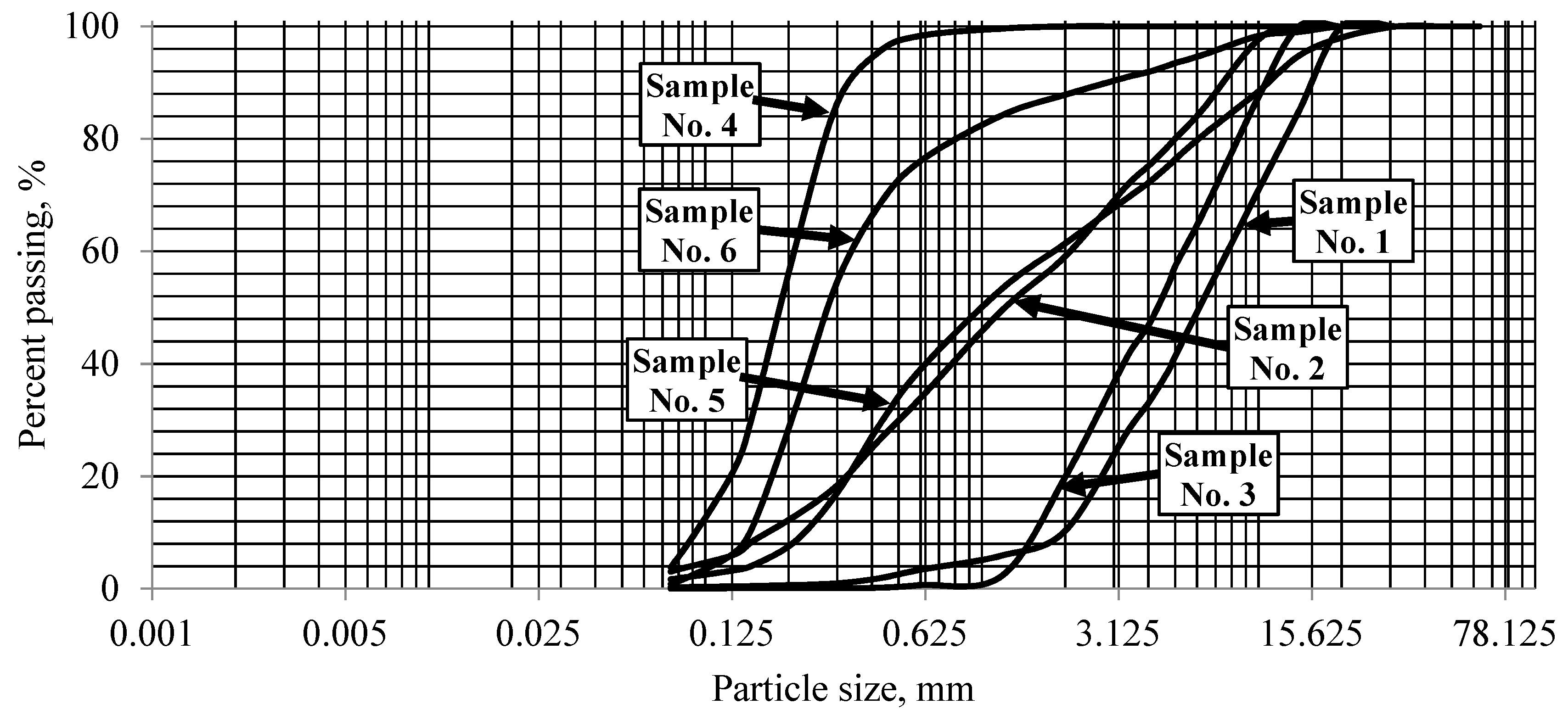
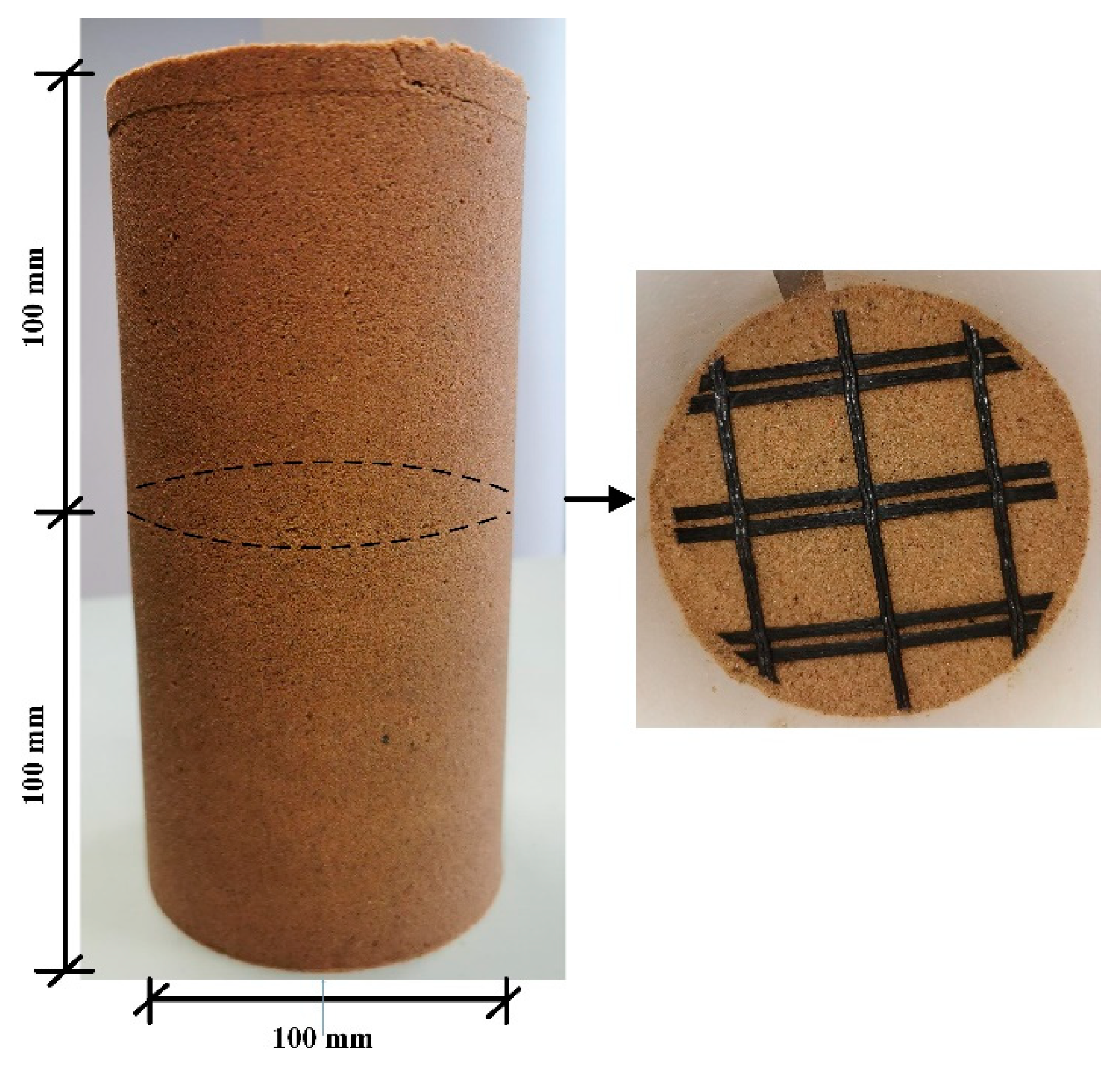
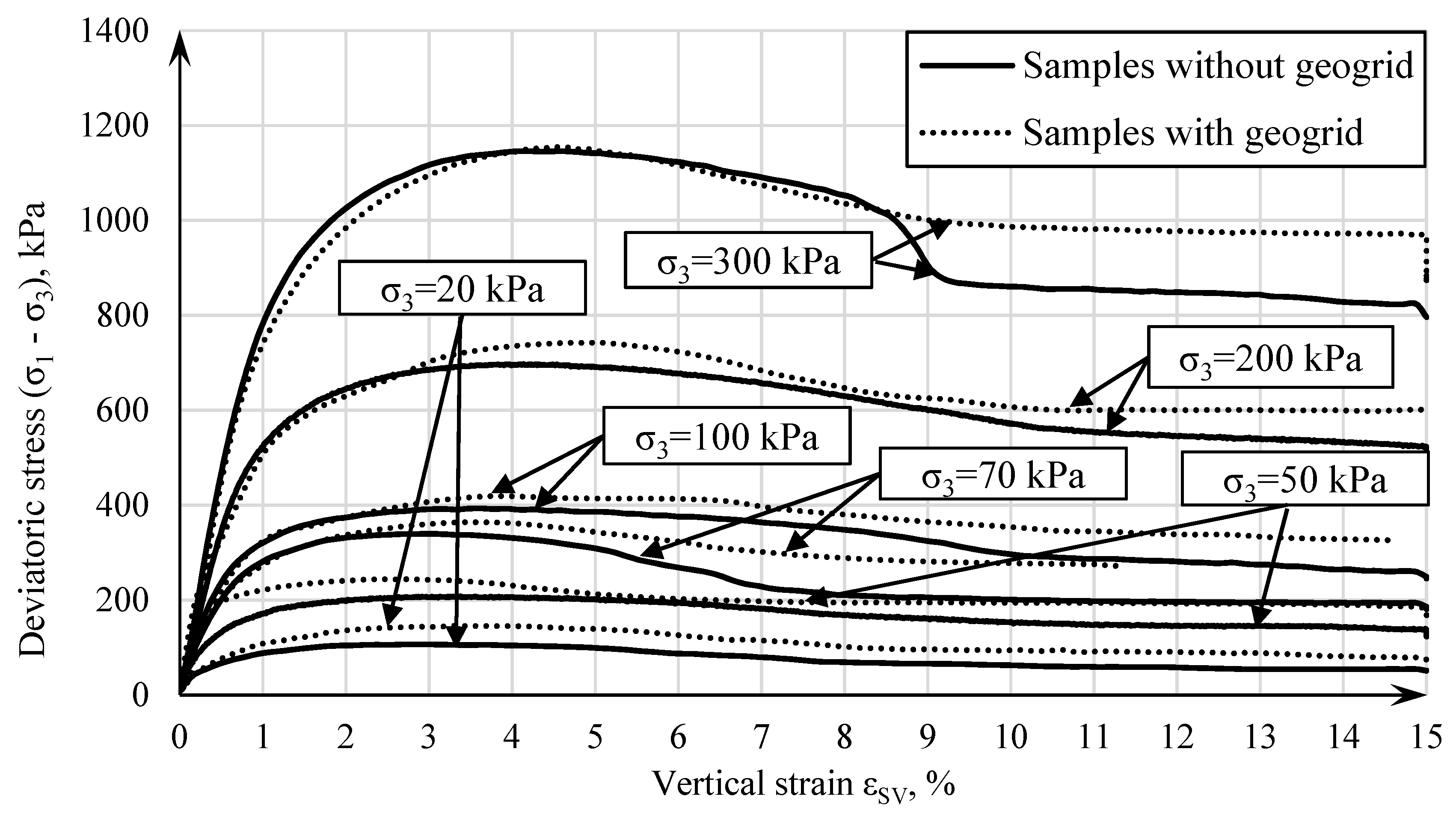
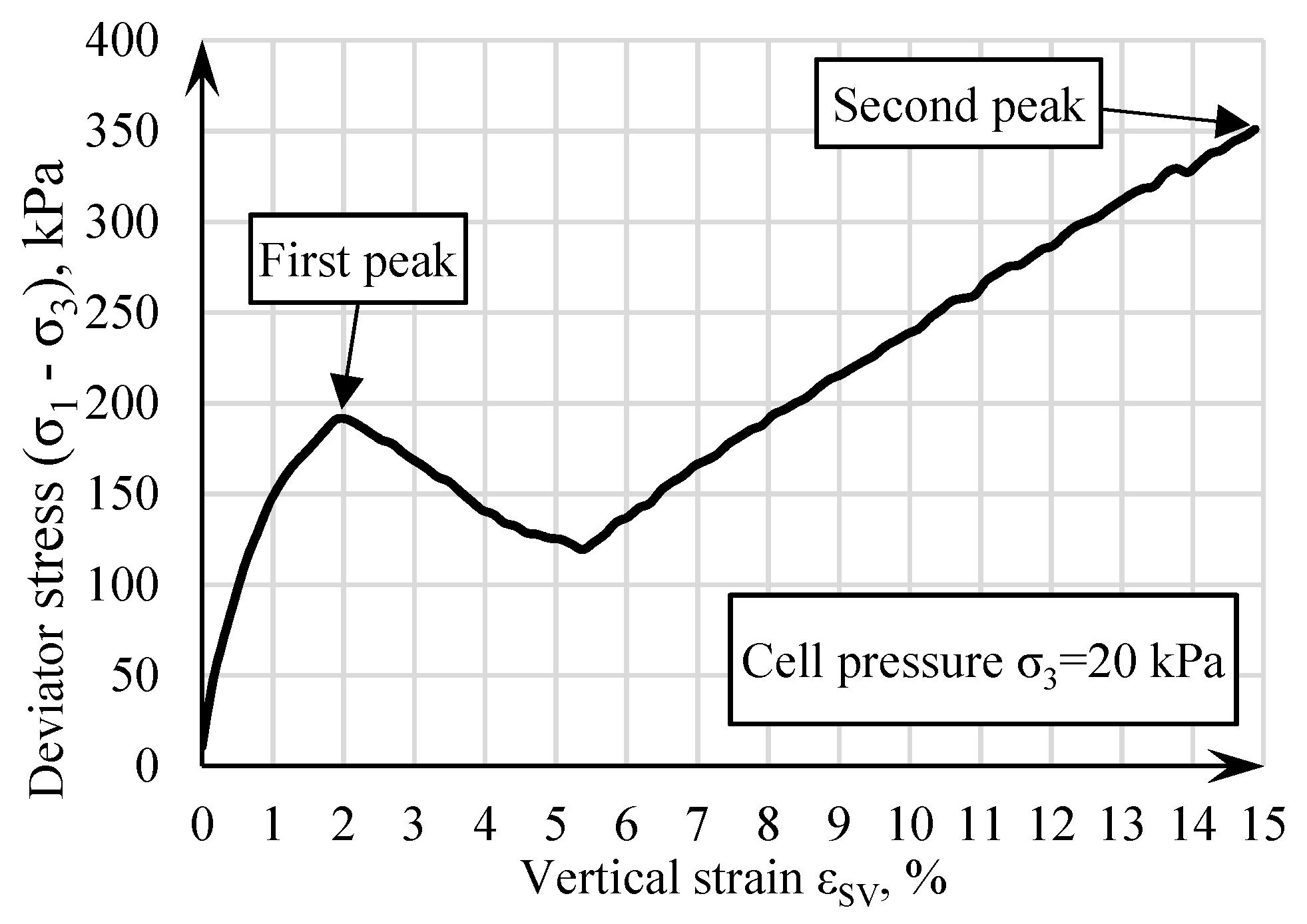


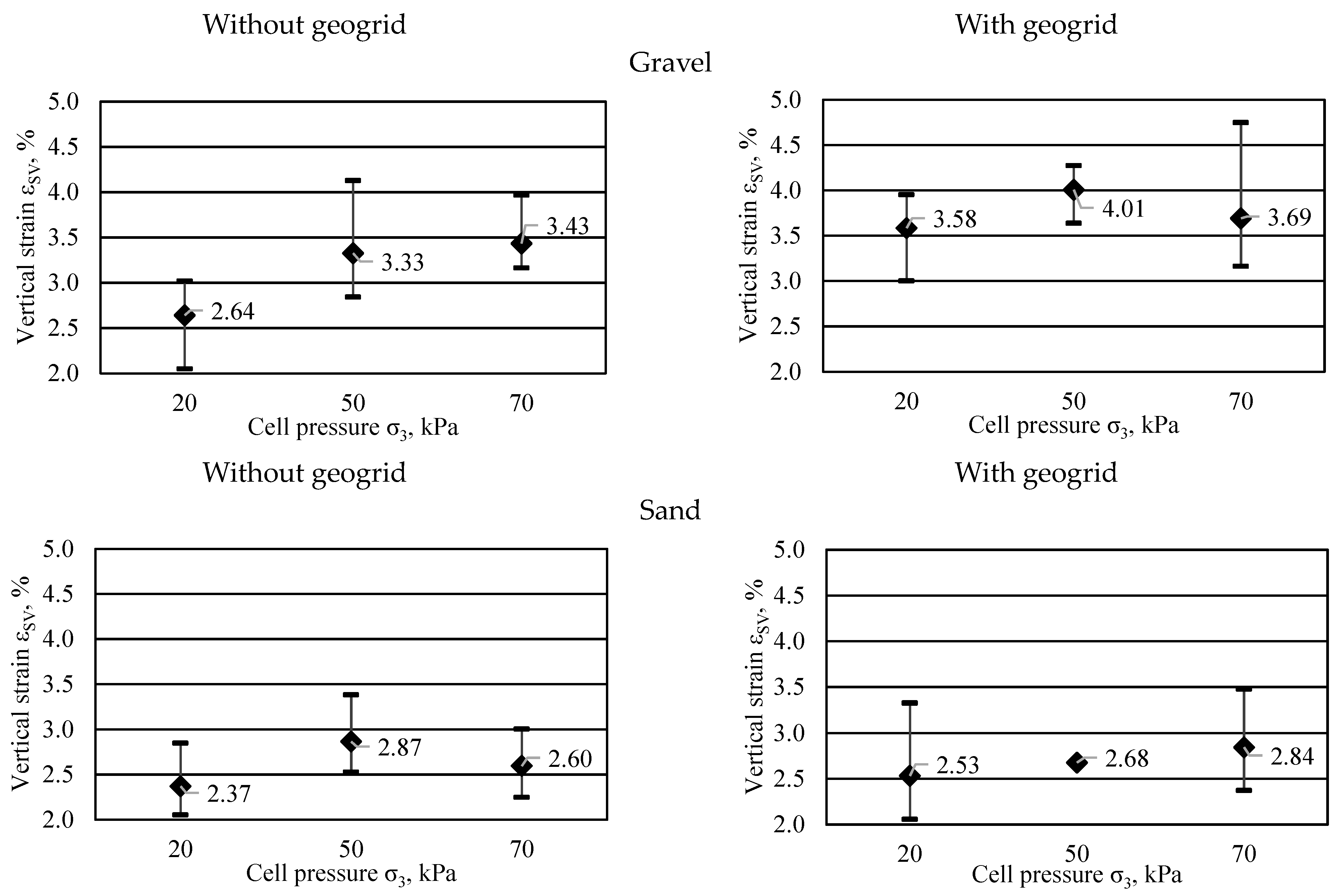
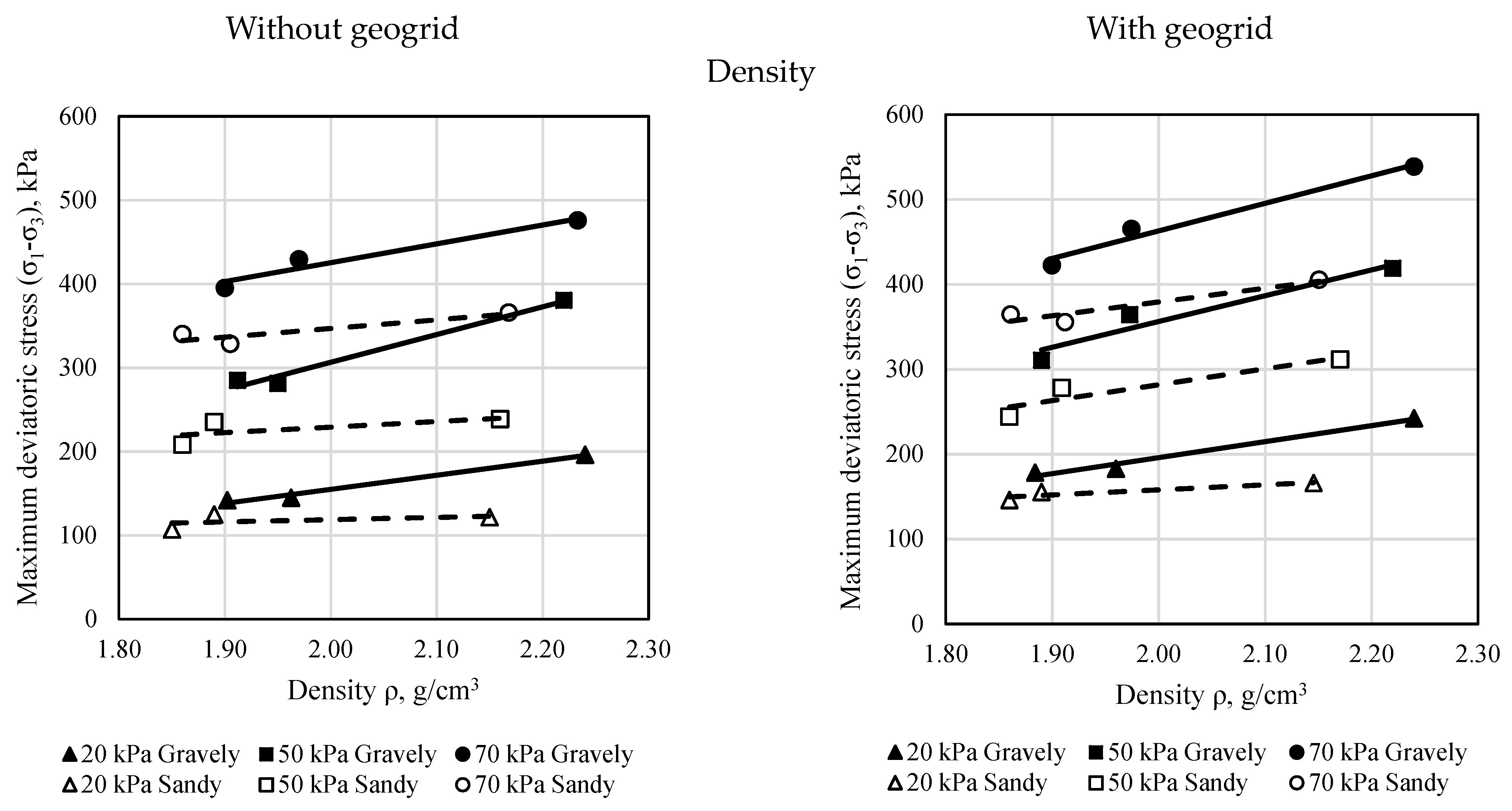
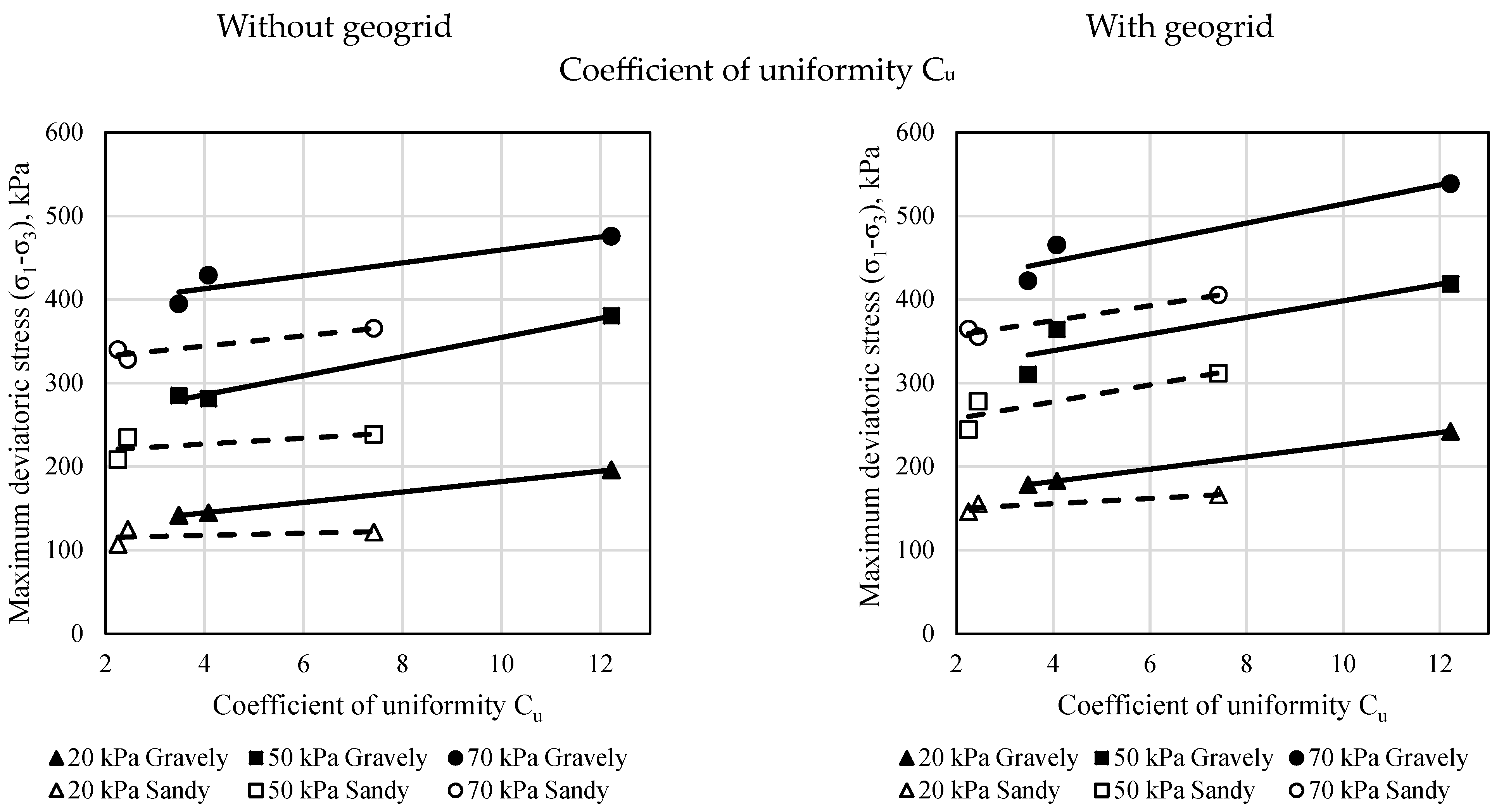
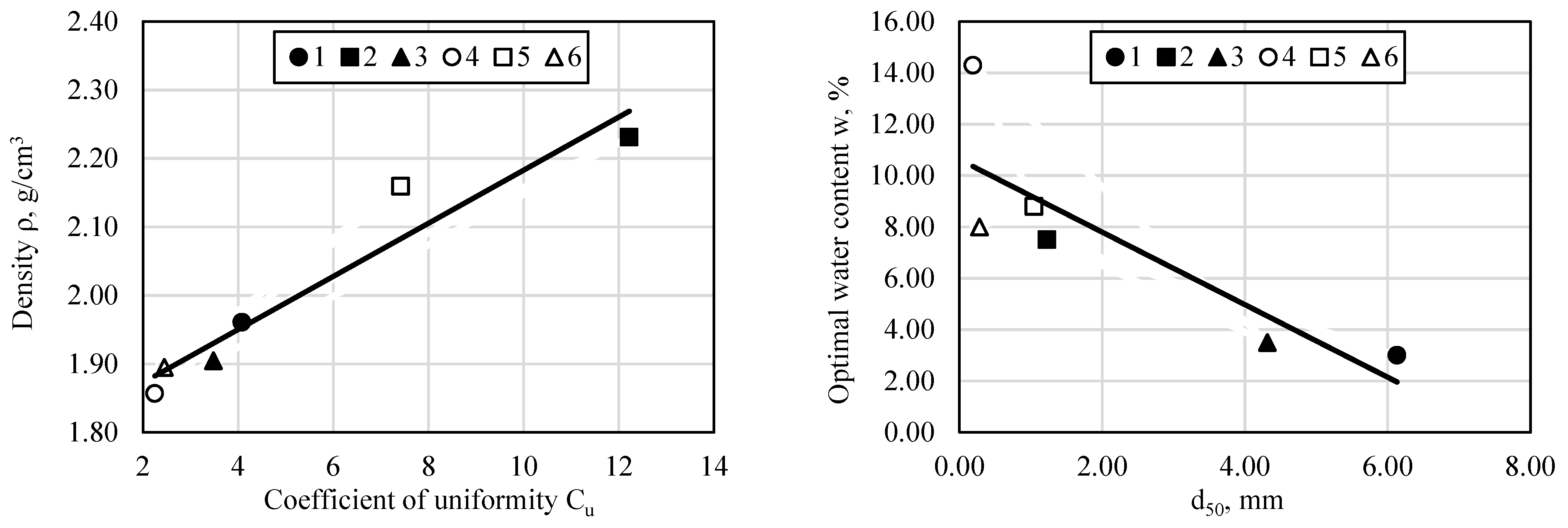
| Sample No. | Soil Classification System | d10 | d30 | d50 | d60 | CU | CC | ||
|---|---|---|---|---|---|---|---|---|---|
| LST 1331:2022 | LST EN ISO 14688-2 | Unified Soil Classification System | |||||||
| 1 | ŽB | GrP | GrP | 1.95 | 3.62 | 6.13 | 7.94 | 4.08 | 0.85 |
| 2 | ŽG | GrM | GrP | 0.17 | 0.51 | 1.23 | 2.10 | 12.22 | 0.72 |
| 3 | ŽP | GrP | GrP | 1.54 | 2.64 | 4.31 | 5.37 | 3.48 | 0.84 |
| 4 | SB | SaU | SaP | 0.09 | 0.15 | 0.19 | 0.21 | 2.25 | 1.08 |
| 5 | SG | SaM | SaP | 0.23 | 0.44 | 1.05 | 1.69 | 7.42 | 0.51 |
| 6 | SP | SaU | SaP | 0.14 | 0.20 | 0.28 | 0.35 | 2.45 | 0.79 |
| Sample No. * | Water Content Determined by Standard Proctor Compaction Test w, % | Dry Density of the Soil Determined by the Standard Proctor Compaction Test ρd, g/cm3 | Sample Density (Prepared) ρ, g/cm3 |
|---|---|---|---|
| 1 | 3.00 | 1.90 | 1.96 |
| 2 | 7.50 | 2.08 | 2.23 |
| 3 | 3.50 | 1.83 | 1.90 |
| 4 | 14.30 | 1.65 | 1.86 |
| 5 | 8.80 | 1.98 | 2.16 |
| 6 | 8.00 | 1.75 | 1.90 |
| Property | Unit | Value |
|---|---|---|
| Mesh size | mm | 25 × 25 |
| Mass per unit area | g/m2 | 260 |
| Ultimate tensile strength | kN/m | ≥40 |
| Strain at nominal tensile strength | % | ≤10 |
| σ3, kPa | Deviatoric Stress (σ1–σ3), kPa | Reinforcement Effect Rσ | |
|---|---|---|---|
| Without Geogrid | With Geogrid | ||
| 20 | 106.94 | 145.98 | 1.37 |
| 50 | 208.04 | 244.19 | 1.17 |
| 70 | 339.94 | 364.48 | 1.07 |
| 100 | 393.21 | 419.12 | 1.07 |
| 200 | 697.33 | 742.13 | 1.06 |
| 300 | 1146.01 | 1154.49 | 1.01 |
| Sample No. * | Test Conditions | Maximum Deviatoric Stress, kPa | Reinforcement Effect Rσ | ||||
|---|---|---|---|---|---|---|---|
| σ3 = 20 kPa | σ3 = 50 kPa | σ3 = 70 kPa | σ3 = 20 kPa | σ3 = 50 kPa | σ3 = 70 kPa | ||
| 1 | Without geogrid | 144.68 | 281.32 | 428.96 | 1.26 | 1.30 | 1.08 |
| With geogrid | 182.92 | 364.40 | 465.12 | ||||
| 2 | Without geogrid | 195.97 | 380.48 | 475.56 | 1.24 | 1.10 | 1.13 |
| With geogrid | 242.31 | 418.88 | 538.55 | ||||
| 3 | Without geogrid | 141.78 | 284.98 | 394.80 | 1.26 | 1.09 | 1.07 |
| With geogrid | 178.30 | 310.54 | 422.40 | ||||
| 4 | Without geogrid | 106.94 | 208.04 | 339.94 | 1.37 | 1.17 | 1.07 |
| With geogrid | 145.98 | 244.19 | 364.48 | ||||
| 5 | Without geogrid | 121.65 | 238.46 | 365.49 | 1.37 | 1.31 | 1.11 |
| With geogrid | 166.10 | 311.58 | 405.40 | ||||
| 6 | Without geogrid | 124.75 | 234.97 | 328.17 | 1.25 | 1.18 | 1.08 |
| With geogrid | 155.48 | 278.17 | 355.52 | ||||
| Average | 1.29 | 1.19 | 1.09 | ||||
| Sample No. * | Without Geogrid | With Geogrid | Difference | |||
|---|---|---|---|---|---|---|
| φmean, ° | cmean, kPa | φmean, ° | cmean, kPa | φmean, ° | cmean, kPa | |
| 1 | 48.38 | 0.00 | 48.15 | 7.03 | −0.23 | 7.03 |
| 2 | 48.46 | 6.29 | 48.87 | 16.39 | 0.41 | 10.10 |
| 3 | 46.35 | 0.85 | 45.76 | 9.31 | −0.59 | 8.47 |
| 4 | 44.24 | 0.00 | 43.98 | 3.61 | −0.26 | 3.61 |
| 5 | 45.44 | 0.00 | 44.71 | 9.94 | −0.73 | 9.94 |
| 6 | 43.10 | 1.81 | 42.38 | 10.65 | −0.30 | 8.84 |
Disclaimer/Publisher’s Note: The statements, opinions and data contained in all publications are solely those of the individual author(s) and contributor(s) and not of MDPI and/or the editor(s). MDPI and/or the editor(s) disclaim responsibility for any injury to people or property resulting from any ideas, methods, instructions or products referred to in the content. |
© 2023 by the authors. Licensee MDPI, Basel, Switzerland. This article is an open access article distributed under the terms and conditions of the Creative Commons Attribution (CC BY) license (https://creativecommons.org/licenses/by/4.0/).
Share and Cite
Zakarka, M.; Skuodis, Š.; Dirgėlienė, N. Triaxial Test of Coarse-Grained Soils Reinforced with One Layer of Geogrid. Appl. Sci. 2023, 13, 12480. https://doi.org/10.3390/app132212480
Zakarka M, Skuodis Š, Dirgėlienė N. Triaxial Test of Coarse-Grained Soils Reinforced with One Layer of Geogrid. Applied Sciences. 2023; 13(22):12480. https://doi.org/10.3390/app132212480
Chicago/Turabian StyleZakarka, Mindaugas, Šarūnas Skuodis, and Neringa Dirgėlienė. 2023. "Triaxial Test of Coarse-Grained Soils Reinforced with One Layer of Geogrid" Applied Sciences 13, no. 22: 12480. https://doi.org/10.3390/app132212480





